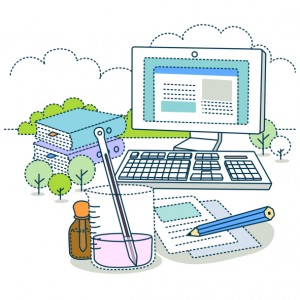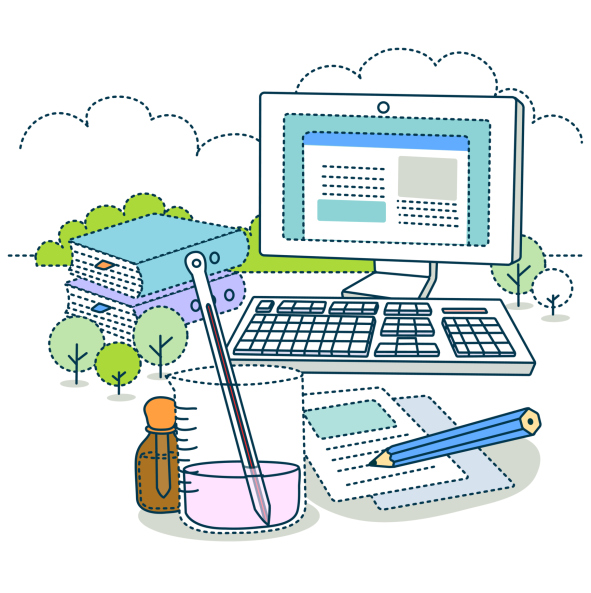
Program Director, Natural Sciences at American Public University
Teaching science in an online environment has always been a challenge. So much so that almost no science degree programs exist in a purely online format. Most scientists just can’t fathom teaching science without the hands-on lab experience that they had when they went to college. However, new technologies and a more complete understanding of outcomes-based teaching are allowing a new generation of scientists to be trained in an online format, with the same (or in some cases, better) effectiveness than traditional on-ground programs.
Can online labs be effective? Researchers are now starting to answer that question. Recent work by Jim Brinson, a PhD student at Indiana State University, noted that 89% of the 86 studies he reviewed showed that achievement of student learning outcomes was equal to, or greater, for non-traditional (online) labs (Brinson, 2014, Brinson and Brinson, 2014). So the short answer is, “yes, online labs can be very effective.”
American Public University recently launched a B.S. in Natural Sciences, with concentrations in biology and earth science. The program is fully online, and features innovative lab technologies and methods to ensure all standards are met for the National Science Teachers Association (NSTA) in either life sciences, or earth and space sciences. The APUS standards are the same as in many traditional programs, but differ in how they are met.
The laboratory work in the program focus on three separate. but related, components: virtual simulations, hands-on experiments, and digital instrumentation. Using these three elements , students build skills in experimental design, laboratory techniques, safety, data collection, data analysis, and other common lab skills.
Virtual Simulations
Virtual simulations have long been the hallmark of online science education, but have traditionally been canned videos or limited virtualizations. However, a new generation of virtual content is being developed which will allow almost limitless exploration, by incorporating “behind the scenes” mathematical representations of physical processes. For example, in a chemistry simulation, if a student mistakenly adds water to a strong acid (rather than adding acid to water), the resultant exothermic reaction is being modeled on the back end, and is then demonstrated to the student, possibly “burning” the student’s avatar. Because these simulations are basically complex mathematical models of physical processes, faculty have the ability to craft custom experiments from virtual store rooms, without the limitations of cost, expense, safety, or disposal . Additionally, with virtual dissections, issues with squeamish students and those with ethical challenges to dissection are eliminated, while providing students with an excellent learning opportunity.
Hands-on Experiments
While much can be done in the virtual world, there are of course limitations. It’s hard to simulate the fragility of a graduated cylinder, the crystal structure of a sample of granite, or the intricacy of a fetal pig’s spine. Hands-on kits are available from multiple vendors to provide students with actual hands-on lab experiments. These kits are designed to balance standards-based effectiveness with cost, safety, disposal, and shipping ability. Additionally, the kits are generally customizable and all-inclusive. A common concern from universities thinking about “kitchen science” deals with liability. If a student is injured while performing an experiment, who gets sued? In general, the kits are designed to pre-empt such issues, and manufacturers usually assume that liability from the university.
Digital Instrumentation
An exciting aspect of science is how advances in instruments and digital data collection have expanded the types of questions that scientists can ask. In a traditional lab environment, students are exposed to complex instrumentation as part of the lab infrastructure. However, to replicate this in the online space has been challenging, until now. Recent advances in technology have allowed several companies to produce “plug and play” instruments that are low-cost, simple to use, and near research quality. These instruments generally plug into a base unit with multiple capabilities, usually including Bluetooth, Wifi, GPS, touchscreen, and data logging capabilities. The base units can serve as stand-alone displays for plugged sensors, data loggers for long-term deployment, or as interfaces between instrument and computer for more robust data collection and real-time analysis. As a student moves through the program at APU, they will acquire different sensors that will plug into the same unit. By the time they reach the final course, they will have a nice quiver of tools (sensors, base unit, and skills) to draw upon to carry out their own inquiry-based capstone research project.
By combining the advanced virtual simulations, hands-on kits, and digital instrumentation and data collection, APU is demonstrating that standards-based science education can be done online. This is a significant advancement, as it opens up science education to almost anyone, whereas previously, science degrees were really only available to those who could travel to a campus.
About the Author
Danny Welsch is a professor and program director for science at American Public University. He holds a MS in Forest and Environmental Engineering from the State University of New York, and a PhD in Environmental Science from the University of Virginia. He researches, lives, and writes from the mountains of Western Maryland.

Comments are closed.